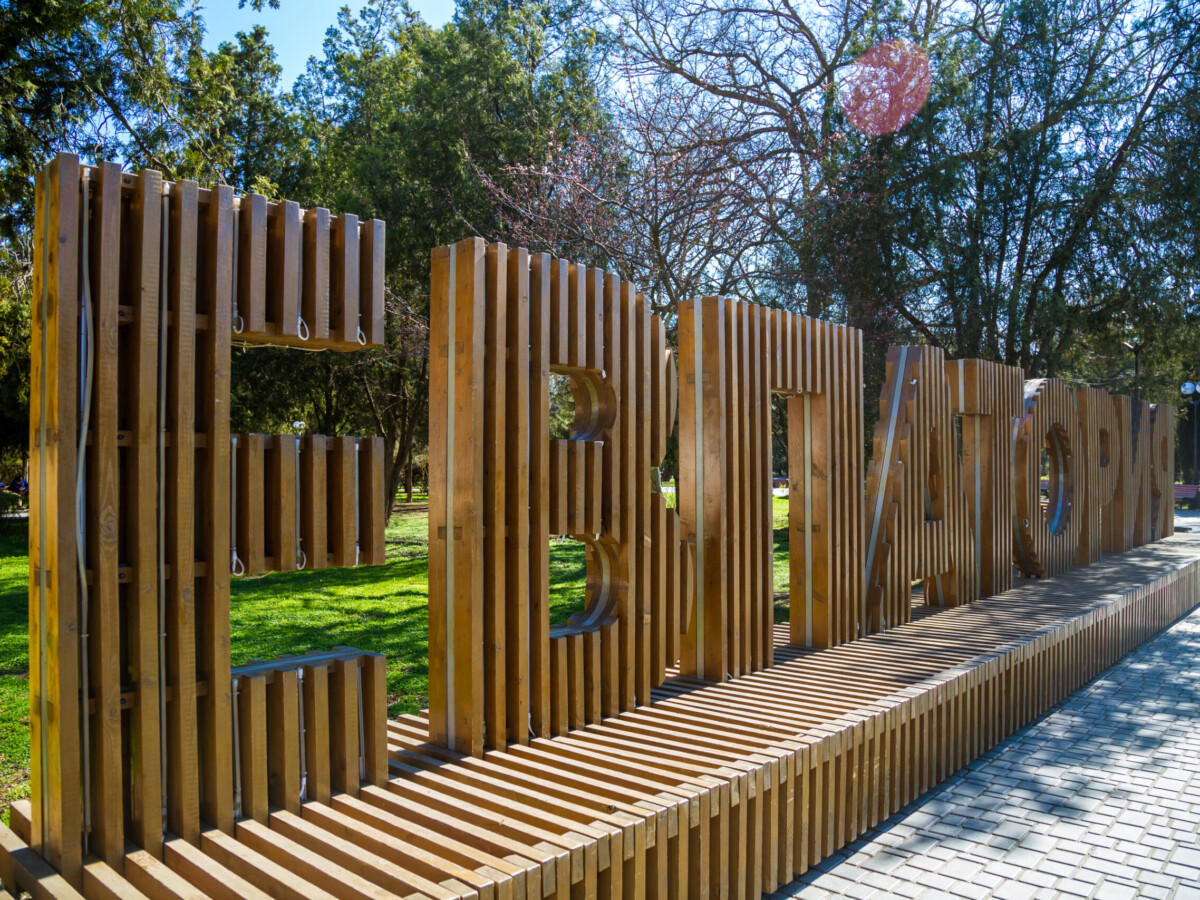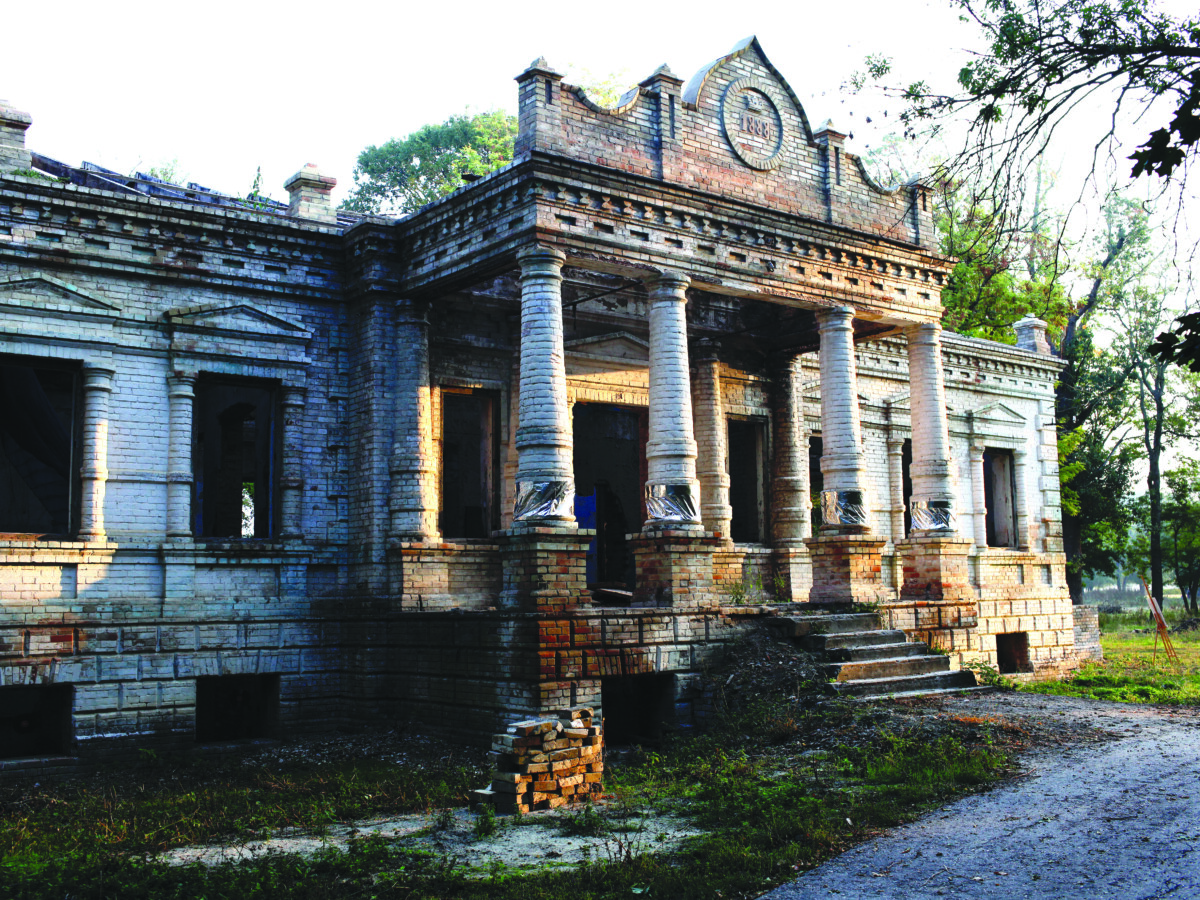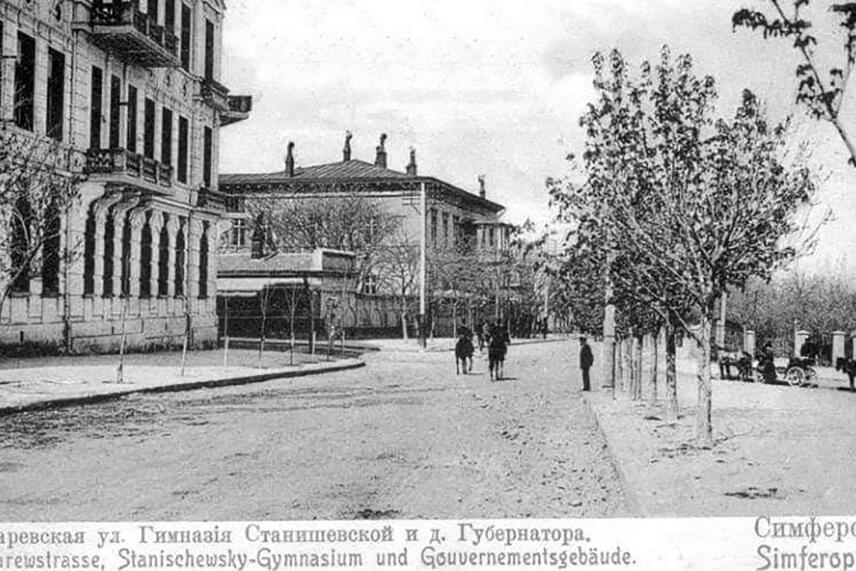When you start thinking of Yevpatoriya, you will definitely see visual images of a sea fringed with sandy beaches. The sea is not the only beautiful place in the city. Yevpatoriya exists more than 2500 years. Walking in the center of the city, tourists will be able to notice a plenty of curious details carrying cultural grounds of the ancient Greek civilization. Medieval Gezlev’s temples standing not far from each other can be called the real impersonation of kindheartedness and religious tolerance.
Reference:
Yevpatoriya was situated in VI-th century B.C. The total area of the city is 65,5 km2. The population of Yevpatoriya is 107,650 people.
1) Memorial Wall In Honor Of The 2500 Anniversary of Yevpatoriya
2) Museum of Local Lore
3) Monument to Heracles
4) Pushkin Theatre in Yevpatoriya
5) Central City Library
6) Cathedral of St. Nicholas
7) Khan-Jami Mosque
8) Karaite kenassas
9) Egie Kapai Synagogue
10) Dervish Tekie
Saturday is the first part of our tourist journey. This day, we are going to research the most noticeable traces the Antiquity. Join us!
Take a look at Memorial Wall In Honor Of The 2500 Anniversary of Yevpatoriya
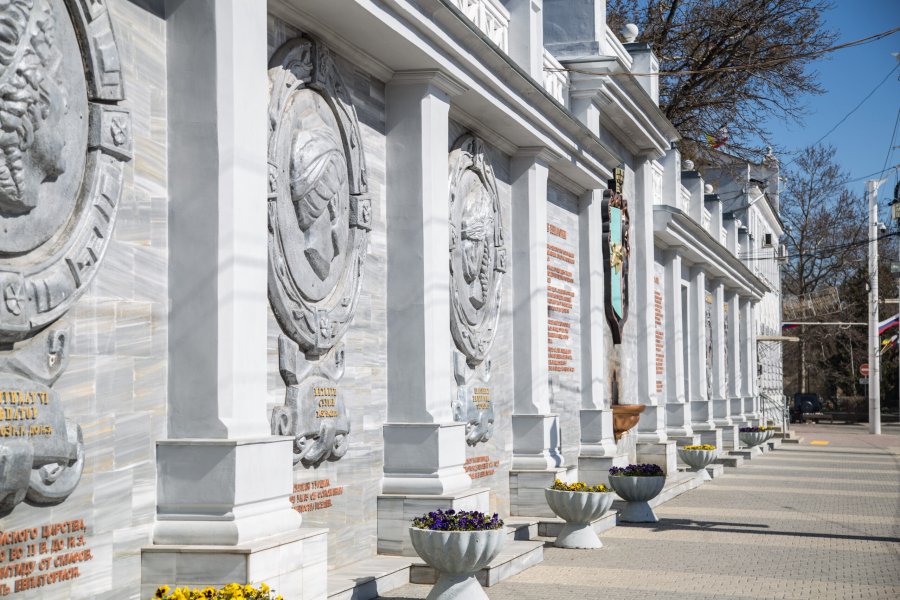
The city’s history goes back about twenty five centuries. During that period, Yevpatoriya bore three different names. Kerkinitis was the name of the city in the Antique Times. The Crimean Khanate’s governors renamed the city into Gezlev (Kezlev). Nowadays, the city is well-known as Yevpatoriya. Each unique title contains its own particular historical epoch. The ancient Greek colonists, Crimean Tatar khans and finally joining the peninsula to the Russian Empire are main events in the history of Crimea. There is the Memorial Wall In Honor Of The 2500 Anniversary of Yevpatoriya on the Teatralnaya Square. In the middle of the composition, a sculptor placed the Holy Fire and Yevpatoriya’s coat of arms. According to the legends, the flame in honor of the goddess of the family hearth Hestia was brought by the Greek colonists, who situated Kerkinitis in VI A.D. The fire was a symbol of welfare and prosperity and it was kept burning in every house. A coat of arms of Yevpatoriya was adopted in 1844 by the emperor Nicholas the First. The shield is decorated with pictures of a ram’s head and snake wrapping around the rod and inclining to the cup. The coat of arms’ symbolism tells us about an advantage of the Western Crimea and its capital Yevpatoriya. The description reads “a ram’s head points at the convenience of sheep farming in Tarkhan Highlands”. The cup and snake emblematize remedial muds and defines Yevpatoriya as a resort. Near the coat of arms and Holy Fire, you will find portraits of the Russian empress Catherine the Great, Mehmed the Conqueror, governor of the Kingdom of Pontus Mithridates VI Eupator and historian Herodotus of Halicarnassus, who are considered to be the most prominent personalities influenced on the city’s history.
Visit Museum of Local Lore
A magnificent exposition reflects a 2500 years historical period of Yevpatoriya. Bas-reliefs of Heracles are the most recognizable exhibits of the Antique Times. Many centuries ago, these sculptures made of local limestones were indispensable parts of home sanctuaries of citizens of Kerkinitis and its outskirts. The worship of a famous hero of the Greek mythology and son of Zeus was common within the whole ancient oecumene, including Tauris. Everybody knows about Heracles and his Twelve Labours. However, all Heracles’ sculptures found in the Western Crimea show the hero relax. He lays on the pelt of the slain Nemean Lion and holds a goblet of wine.
The Yevpatoriya Museum of Local Lore works daily, except Wednesday. It opens at 10,00 am and closes at 5,00 pm. A full ticket will cost 150 roubles for adults. Pensioners will have to pay 120 roubles. A kid ticket costs just 90 roubles. Adult people will have to spend 210 roubles for full excursion tickets. Retired citizens will pay 180 roubles. Children are able to enter the museum for 150 roubles.
Take a selfie with Resting Heracle
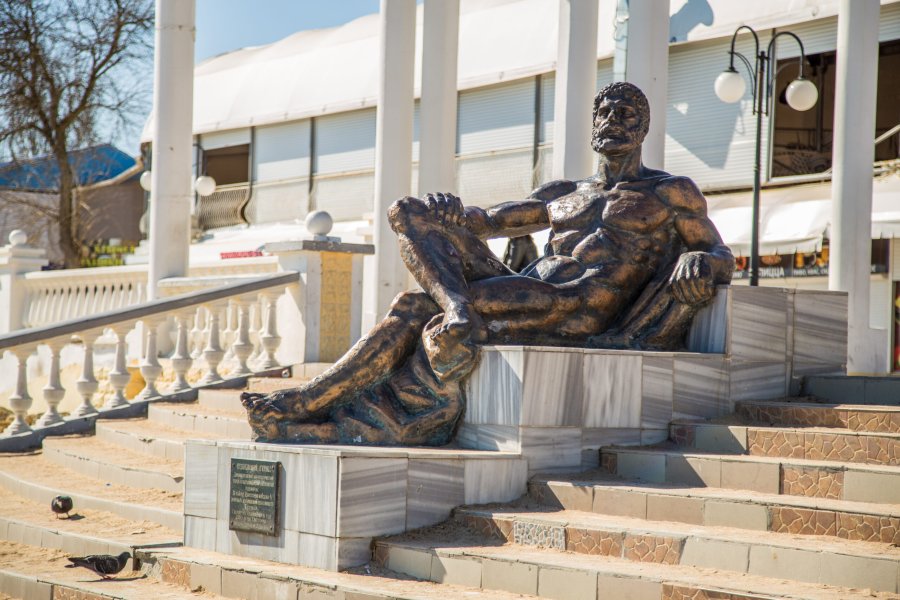
The legend about Heracle wishing to rest on the territory of Taurica after every new performed labour is based on the artifacts of the Ancient Times. On the edge of millennium, a sculpture “Relaxing Heracle” was installed on the city’s embankment overlooking the local beach. It may seem that a half a man, and half a God wants to tells us: “This world is a place to perform labors in. Yevpatoriya is the only place to rest at!” It’s a particularly curious fact that a sculptor of the “Relaxing Heracle” monument Aleksei Shmakov carved another city’s sculpture “Boy with the weight” more than fifty years ago. It shows us a young sturdy child trying to handle with 16 kg dumbbell. As sculptures are located not far from each other, so we can say it’s the same Heracle, but in different ages.
See Pushkin Theatre in Yevpatoriya
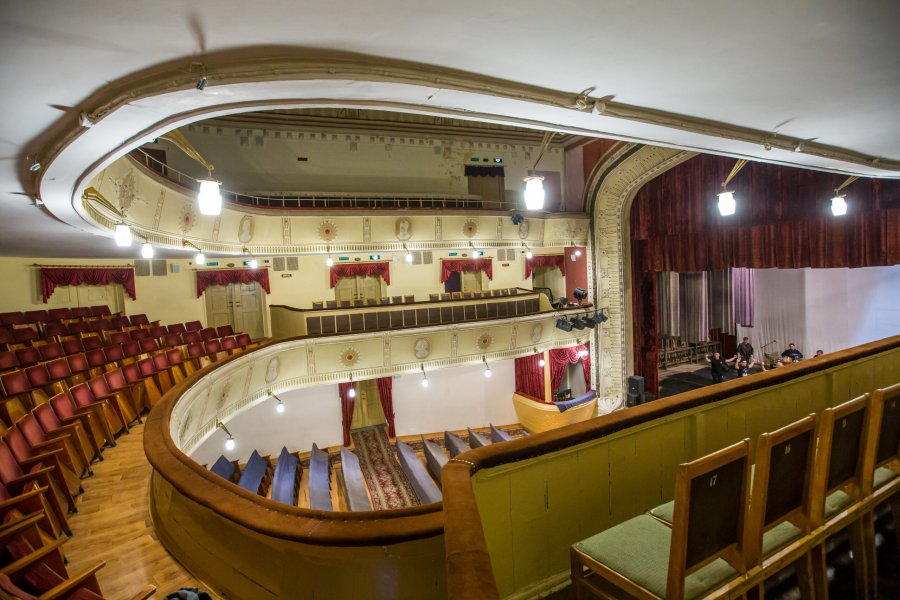
It’s quite symbolic that the work “Histories” by Herodotus is also named “Muses” and a chapter dedicated to the city of Kerkinitis called “Melpomene”. Melpomene is a patroness of tragedy in the ancient Greek mythology. The muse clutches a club or knife in one hand and holds a tragic mask in the other. It’s highly likely Melpomene used these weapons to attack on human weaknesses. One of such downsides is a theatre disinterest. Nevertheless, the muse must be favorable to citizens of Yevpatoriya. In 1910, due to the initiative of Yevpatoriya’s mayor Semen Duvan the central city square was completed with a theatre, which can be called a true majestic temple of Melpomene. The project designers are two architects from Yevpatoriya. Adam Genrikh and Pavel Seferov worked on the original styled design of the building, where features of modern and classicism shape strongly marked antique patterns. Tragic masks and facade bas-reliefs of gryphons keep reminding of episodes of the ancient history of Yevpatoriya. High feet lamps with simulated spurts of flame installed on the theatre’s roof attract people’s attention too.
Sunday is the second part of our tourist trip. Let’s know more about old-time temples of “Little Jerusalem”.
Our traveling itinerary around a long standing part of the city includes an acquaintance with amazing objects and interesting historical facts of Yevpatoriya. This small and clean city could unite representatives of different nationalities. Orthodox cathedrals, moslem mosques, Jewish synagogues and Karaite kenassas are located within a walking distance from each other. All these religious buildings are historical and cultural monuments. When worship services are not held, temples receive excursion groups.
Light a candle at Cathedral of St. Nicholas
The Orthodox Cathedral of St. Nicholas was raised in the end of XIX century in the memory of liberation Yevpatoriya from English, French and Turkish troops during the period of the Crimean War in 1854-1856. The temple was built under the influence of Byzantine architectural traditions. A huge reinforced concrete dome is an engineering innovation. The cathedral is decorated with three kinds of crosses. Saint George’s crosses on the top of the fence personify the military valor of Russian heroes fallen in the Crimean War. Column Byzantine crosses underline the mental continuity with Constantinople’s heritage. Russian Orthodox crosses crown the domes.
Visit Juma-Jami Mosque

The largest moslem temple of the Republic of Crimea is a cathedral mosque in honor of the Holy Friday Juma-Jami. The mosque was built by the great Turkish architect Hoja Mimar Sinan in 1552. A temple’s composition is quite similar to the grand Hagia Sophia in Istanbul. All eighteen khans of Crimea made an oath on a sword and Quran to serve for the good of their people. Therefore, the other name of the mosque is Khan-Jami (“Khan Mosque”).
Enjoy a view of Karaite kenassas
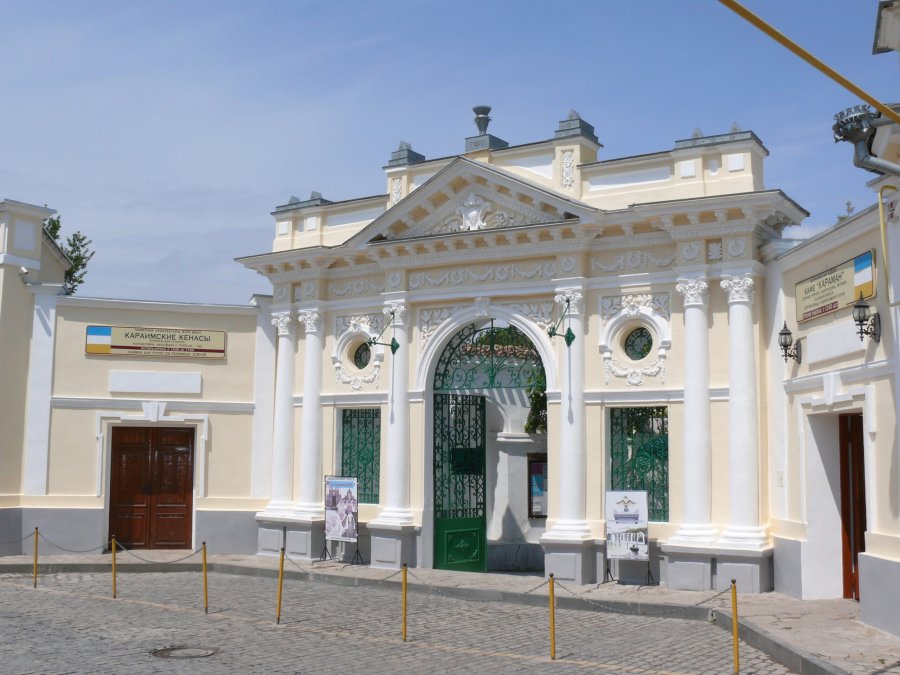
In 1807-1815, Yevaptoriya got temples of Karaites. White marble flagstones with ancient Hebrew writings on them are carefully covered with centennial vines. People following Karaism perceive Yevpatoriya in the same way, as moslems revere Mecca or catholics honor Rome. Besides of religious rooms, you can find a museum of history and culture of Karaites and ethnic cuisine cafe inside of kenassas.
Enter Egie Kapai Synagogue
A Jewish worship house was raised in 1912 with assistance of city craftsmen. A facade round window possesses a stained-glass hexagram. Up above the Star of David, a designer placed a stone styled image of Tablets of Ten Commandments. A main facade framing looks like the Wailing Wall of Jerusalem.
Get familiar with Dervish Tekie
Dervish Tekie (translated as “tenement of beggars”) is an old moslem temple built in XV century. Traveling ascetics and monks, who were members of the Mevlevi Order liked to accomplish their ritual practices in that place. Visiting the object, tourists get an opportunity to see living conditions of adherents of this mystical and philosophical eastern teaching. There are also special excursions by a request. If you join that arrangement, you will see “interactive situations” of Sufis’ everyday life, such as elements of whirling (Sama ritual) and famous dervish music. The Architectural and Historical Ensemble accommodates the Ethnographic Museum dedicated to Crimean Tatars’ culture and household activities.
Where will you eat?
Taking into the consideration TripAdvisor feedback comments, the “Crimean Magazine” created a list of restaurants and cook-shops, where our dear readers and potential tourists will be able to snack at, while they are out of excursions.
Time to breakfast
If you are an aromatic coffee lover and fond of oriental sweets, then the coffee shop “Kezlev K»Avesi” is waiting for you. Guests of the cafe especially like traditional baked goods, Crimean Tatar natural cezve-brewed coffee and charming inside environment.
Dinner time
After another one excursion, hunger tourists will definitely want to satisfy their appetite. The Anna Akhmatova Literary Cafe is a very interesting place not only for eating, but also enjoying its cozy climate and specific design style. Among a large number of offered viands, clients’ reviews are focused on a cream of champignon soup, chicken liver salad and cakes.
Get some supper
The eastern interior, dressed in national suits personnel, fountain and live music are indispensable elements of the restaurant “Dzheval”. An evening visit is a perfect time for tasting dishes of the ethnic Crimean Tatar cuisine.

